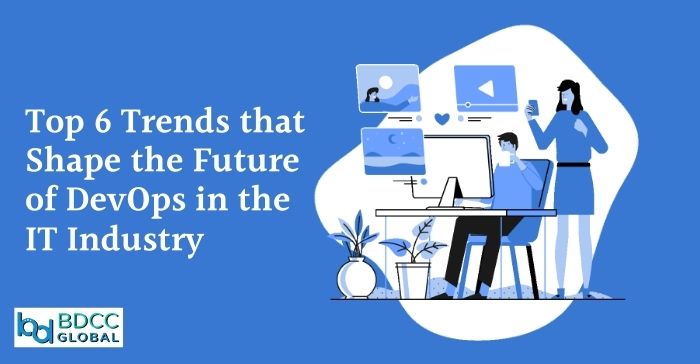
If you notice keenly, you will observe how automation and digitalization have climbed the ladder of evolution. Technology is indeed ever-advancing, and the recent years have experienced it all. One of the biggest headways made in the technological field is DevOps.
The future of DevOps technology is analyzed to experience a surge of $20.01 billion by 2026, increasing at a CAGR of 24.7% counting from the year 2019 to 2026. Quite in anticipation, it is often considered one of the essential software development technologies in the market.
“2022 witnesses a gigantic evolution in the future of DevOps with the popular trends like microservice structure, low-code applications, serverless figuring, and so on…”
6 Popular DevOps Trends in 2022 To Look For
There is a continuous expansion noticed in the DevOps life cycle management as it keeps on transforming suiting to the corporate needs. With facilities like swifter software delivery, refined quality, and great customer satisfaction – every organization is interested in the future of DevOps 2022. Let us now study the topmost DevOps trends to look for.
1. Microservice Structure
One of the topmost trends that define the future of DevOps is the microservice structure. This factor is gradually seeking popularity as a substitute for the classic structure in the IT industry. This structure is described as a method of arranging the computer system into elements accelerating the scale on demand.
It is instrumental in offering DevOps operations fantastic agility and scalability throughout the software development lifecycle. A DevOps engineer future scope greatly benefits from this structure since they can tailormade the requirements according to the business need.
2. Serverless Figuring
One of the trends that describe the future of DevOps is serverless computing. Businesses will witness a rise in the adoption of serverless computing majorly because of the massive CAPEX capital expenditure and OPEX or operating cost of server infrastructure. These two are driving factors in shaping the future of DevOps increasing the need for serverless DevOps processes. Additional prime factors that determine the need for the serverless structure are dependability, adaptability, speed, and cost-efficiency.
3. Advance Use of Container Technologies
One of the factors adding to the list of trends shaping the future of DevOps is the increasing use of container technologies. Since containers are lightweight and self-contained environments, it gets more convenient to lead and handle web applications. In fact, by 2023, Gartner anticipates the use of two or more containerized applications by abundant companies. The incorporation of Kubernetes and container-based assistance for the depository, networking, and protection will increase.
4. Low Code Applications
During the pandemic, the switch to low-code applications was quite noticeable. It offers a swift mechanism in DevOps operations. The life cycle management of businesses is expected to be greatly handled by low-code software by the end of this year. The reason is, the immense surge in productivity which is otherwise quite absent.
DevOps life cycle is positively affected by these applications since it also permits non-technical people to contribute to software growth with the support of a visual interface. As this trend develops, the low-code adoption is anticipated to pillar the complete DevOps maturity model. This means, there will be increased support for the important aspects of the future of DevOps pipeline that includes app creation, software configuration, code evolution, testing, release administration, and documentation.
5. Kubernetes Towards Growth
What is Kubernetes and how will it impact the future of DevOps? Kubernetes is an open-source container orchestration structure that is among the newest DevOps future trends. It is more inclined towards the operations side. But professionals foresee the entry of Kubernetes into the software development realm in 2022. This significant difference will alleviate the hurdle of starting a local Kubernetes batch on a developer’s machine.
The security of Kubernetes is perceived to notice a big leap since there is a huge opportunity through infrastructure as a code (IaC) scanning. Furthermore, GitOps is a Kubernetes-based program that enables developers and IT operators to employ Git for handling the clusters and conveying efficient applications.
6. AI and ML-Driven
Artificial and machine learning already plays a huge role in changing the course of business. AI and ML have rightfully been listed as the trends shaping the future of DevOps because they are highly instrumental in shifting the DevOps ecosystem to another level. This is done by modernizing and accelerating every segment of the SDLC with the AI and ML amalgamation.
The future of DevOps is significantly shaped by certain technological factors, and sweeping factors are developing its future. DevOps will thoroughly experience an expansion in the IT industry in the years to come. And this change will directly affect the progress of business software solutions. In case you are inquisitive about the trends affecting the future of DevOps and wish to learn about its implementation on your start-up, then connect with Algoworks. The company will guide you in the correct incorporation of this technology by lining up the development and operations team.
BDCC
Latest posts by BDCC (see all)
- DataOps vs DevOps: Everything You Need To Know - April 23, 2024
- Crafting Your DevOps Testing Strategy: Discover Top Tools & Best Practices - April 18, 2024
- Introducing AISecOps: Reshaping AI & ML Security Utilizing DevSecOps - April 12, 2024

